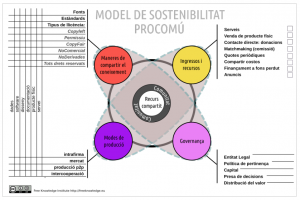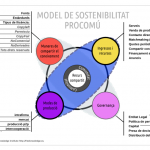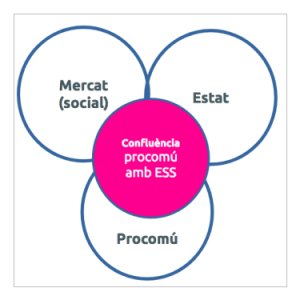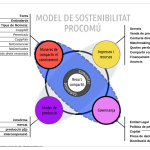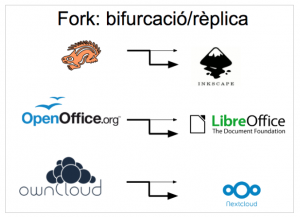This post is also available in: English
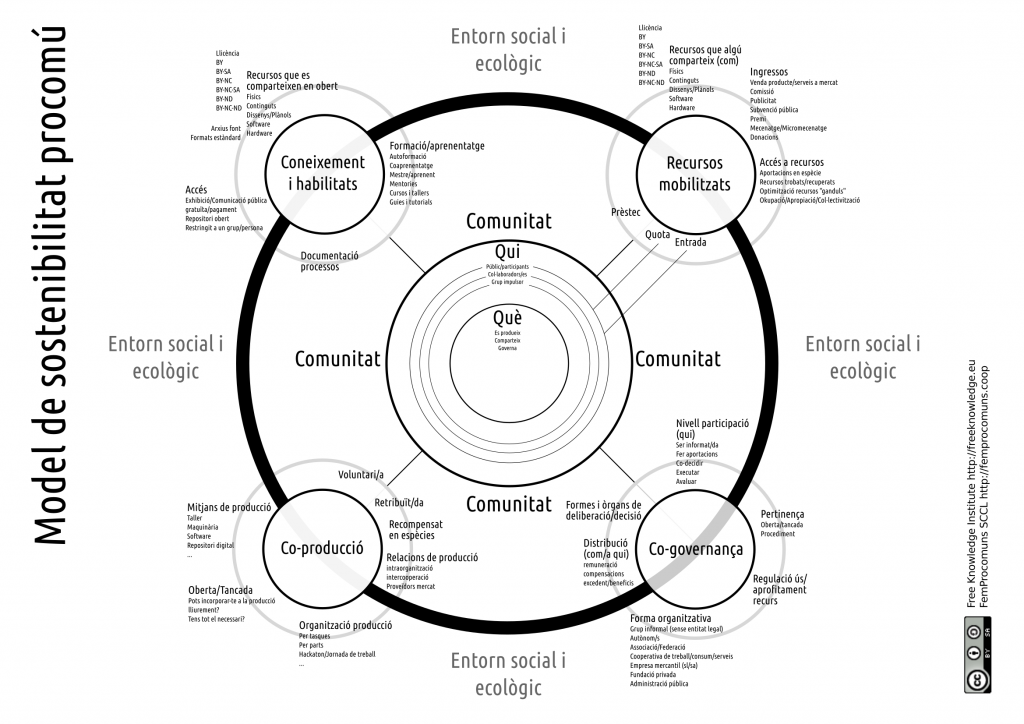 Wouter Tebbens, David Gómez i Mònica Garriga
Wouter Tebbens, David Gómez i Mònica Garriga
Article publicat al llibre: Sharing Cities Action. Dimmons Research Group
Introducció
Un model de sostenibilitat és una definició modelitzada de com funciona o es proposa que funcioni un projecte. Són elements clau la proposta de valor – productes o serveis – què es fa, per a quins perfils d’usuari, com es generen ingressos, el model organitzatiu i de finançament i altres elements orientats a la sostenibilitat del projecte.
En el nostre entorn dominen models de negoci majoritàriament enfocats a maximitzar els beneficis privats, però no tots els projectes econòmics segueixen aquesta lògica. Hi ha projectes que generen valor i beneficis però s’han definit com sense afany de lucre, per exemple la cooperativa d’energia renovable, Som Energia. També n’hi ha que generen valor, però no és valor monetari sinó valor d’ús, per exemple una enciclopèdia com la Viquipèdia. I n’hi ha d’altres que no tenen cap font d’ingressos, però generen un valor d’ús pels seus participants, com per exemple el projecte Citybik.es. “Negoci” és una paraula que pot confondre en aquests contextos, el terme “model de sostenibilitat” és més adient perquè es tracta de buscar un model que permeti realitzar l’activitat del projecte i sigui sostenible en el temps i per a les persones que hi participen.
L’equip de Rhishab Ghosh, amb el projecte FLOSS (FLOSS es refereix a les sigles en anglès de Free Libre Open Source Software), van estudiar (2001) amb profunditat models de sostenibilitat (ells n’hi deien de negoci) en el camp del programari lliure.
Des del 2001 Creative Commons va començar a oferir un conjunt senzill i pràctic de llicències genèriques que van des de la completament lliure i permissiva (CC BY), passant per la copyleft (CC BY-SA), fins a la no-lliure amb restriccions per a l’ús comercial (CC NC) o la creació d’obres derivades (CC ND). Les llicències Creative Commons es consideren “llicències obertes” perquè “obren” el paradigma del “tots els drets reservats” a tothom per fer ús i còpies; oferint totes o algunes de les quatre llibertats (freedomdefined.org).
Aquestes llicències permeten desenvolupar models de sostenibilitat en obert, que animen a compartir el coneixement sota llicències obertes, des de les lliures fins les que es reserven alguns drets. Paul Stacey i Sarah Pearson van treballar amb Creative Commons per publicar un llibre electrònic, finançat amb un crowdfunding el 2015, “Made With Creative Commons – Open Business Models” en el qual van definir cinc estratègies per obtenir ingressos: de digital a físic, connectar directament, matchmaking, serveis de valor afegit i pertinença.
És típic que els projectes combinin diferents mètodes, i que el model de sostenibilitat vagi més enllà dels ingressos i l’ús de llicències per compartir el coneixement. Segons Alexander Osterwalder, un model de negoci “descriu la racional de com una organització crea, entrega i captura valor en contextos econòmics, socials, culturals i altres,” [Osterwalder, 2010], però hi ha altres eixos que completen un model de sostenibilitat del procomú.
El professor Yochai Benkler, del Harvard Law School (EEUU), va encunyar (Benkler 2002) el terme “producció entre iguals d’un procomú” (en anglès: “Commons-Based Peer Production”, CBPP), que descriu un nou model de producció socioeconòmic on un gran nombre de persones col·labora de forma voluntària, habitualment a Internet. Aquest tipus de projectes acostumen a tenir estructures menys rígides i jeràrquiques que aquells basats en models de negoci convencionals. Sovint -però no sempre- aquests projectes funcionen sense una necessitat de compensació econòmica a les persones contribuïdores. Benkler distingeix tres models de producció econòmica, intrafirma o producció interna, producció en el mercat i producció entre iguals (p2p).
Benkler va acabar definint la producció entre iguals (peer production, sintetitzat amb l’acrònim “p2p”), després d’anys d’estudi de diverses comunitats d’Internet. Va veure com la blogosfera canviava el paisatge dels mitjans de comunicació; com milers de persones compartien voluntàriament la capacitat de computació que els sobrava als seus ordinadors en el projecte de recerca SETI@home; com persones voluntàries produïen el sistema operatiu GNU/Linux i després produïen la Viquipèdia. Quan el recurs resultant (de la producció p2p) es pot considerar un procomú (digital), podem parlar de “commons-based peer production”, o producció entre iguals d’un recurs comunal. Aquest model de producció ha generat sistemes productius alternatius als models convencionals i es pot considerar un “tercer mode de producció”, com l’anomena Michel Bauwens (Bauwens 2006), que trobem en moltes comunitats d’Internet.
Amb el projecte europeu de recerca P2Pvalue es van investigar 300 comunitats online en diferents categories i sectors amb uns 150 indicadors i variables per comparar el seu funcionament i el fenomen en si. Es van estudiar eines de plataforma per facilitar la comunitat, els règims de propietat i els models de governança, ingressos, llicències, etc.
Un marc d’anàlisi de models de sostenibilitat procomuns
Tots aquests estudis i informes ens han ajudat a definir un marc d’anàlisi de models de sostenibilitat en obert o procomuns, per identificar perquè i com un projecte pot arribar a ser sostenible. En determinats casos, el fet de tenir un model sense compensació econòmica pot fer sostenible un projecte donat que es depèn poc de recursos monetaris per sostenir l’operació. En altres casos, el model contempla la generació d’ingressos per poder pagar als treballadors (assalariats, autònoms, cooperativistes o contractats externs) que mantenen el nucli de l’operació. En tots els casos sembla existir un fràgil equilibri entre les motivacions dels diferents participants: el repte sembla residir en la maximització de la motivació d’un grup suficientment gran i divers de persones que contribueixen (en el model de producció p2p) a parts importants del projecte, amb una política alineada de compartir el coneixement i la governança.
Hem assajat aquest marc de creació i d’anàlisi de models de sostenibilitat en obert i en clau procomú revisant models de sostenibilitat de l’entorn de l’economia col·laborativa i de les plataformes digitals procomuns, en diferents tallers del projecte Digital DIY i en programes com La Comunificadora, en col·laboració amb entitats i expertes de l’economia social i solidària i del procomú.
Els cinc pilars del Model de sostenibilitat del procomú
Figura 1. Marc d’anàlisi de models de sostenibilitat en obert i procomuns.
El tipus de projectes que analitzem s’acostumen a caracteritzar per tenir una visió de transformació social i per ser definits per la seva missió. Amb això es diferencien d’empreses convencionals que venen productes i/o serveis amb l’únic objectiu, o l’objectiu principal, de maximitzar el seu benefici.
Els projectes procomuns també busquen la seva viabilitat econòmica, i ho fan primordialment per impulsar la seva missió d’afrontar reptes socials a través del compartir. El benefici que poden obtenir està subordinat a la missió. Això permet que hi hagi un nucli dur de persones que porta el projecte perquè en comparteix la missió, i pot voler contribuir-hi aportant recursos només per assegurar-se que el projecte existeix, sense rebre’n un benefici econòmic directe.
El procomú, les regles i la comunitat co-creadora al centre
El procomú pot ser el bé o servei o el procés de producció del bé o servei per part d’una comunitat que s’articula mitjançant mecanismes, eines i normes que li permeten regular el seu propi funcionament. La comunitat la configuren persones amb perfils i rols diferents: usuàries o consumidores, col·laboradores o sòcies i impulsores. A la vegada que participen en la co-creació del projecte a través de certes eines i metodologies -en especial metodologies de design thinking i “disseny centrat en l’usuari” (en anglès, User Centred Design), metodologies agile i lean startup– també en són la raó de ser.
Eix ingressos i recursos mobilitzats/producció
Figura 2. Equilibri entre els pilars: “mode de producció” i “ingressos i recursos”
Estratègies d’ingressos i recursos mobilitzats
Dividim els models de sostenibilitat en dos grups, els que tenen transaccions mercantils (que es poden donar en el mercat social) i els que no en tenen (o no les tenen en el seu nucli de generació de valor) i es basen purament en les contribucions voluntàries. El tercer model – el procomú – té en el nucli de generació de valor la contribució voluntària dels seus membres, en el sentit que els actes són realitzats per voluntat pròpia, independentment de l’existència de compensacions econòmiques directes o indirectes. Hi ha un punt de confluència entre el Procomú i l’Economia Social i Solidària, que combina el mercat socialitzat amb les contribucions voluntàries del procomú, com s’il·lustra en la figura 3.
Figura 3. Confluència entre el Procomú i l’ESS
Principals classificacions o mètodes de generar ingressos.
-
Serveis de valor afegit. Serveis que poden incloure formació, consultoria, desenvolupament a mida, hostalatge de programari (lliure), certificació, garanties de servei o de producte.
-
Venda de productes físics. La comunitat comparteix el coneixement de forma lliure, en dissenys oberts o maquinari lliure, però també pot vendre un producte acabat o en forma de kit a persones que no volen o no ho poden fer per si mateixes. També es pot vendre merchandise (productes físics vinculats a la pertinença i identificació simbòlica amb el projecte).
-
Contacte directe. Les comunitats online apropen els autors i productors al seu públic, es dóna un efecte de desintermediació que genera noves possibilitats relacionals. Les usuàries finals o el públic pot gaudir de l’experiència o la sola existència del projecte i fer donacions. Les campanyes de donacions i de crowdfunding (micromecenatge) en són un bon exemple. Per la realització d’un primer producte es pot involucrar la comunitat i fer pre-venda per cobrir part de les despeses de l’I+D.
-
Matchmaking. Es refereix a entorns o plataformes on es casa l’oferta amb la demanda. Si hi ha una transacció monetària centralitzada, és habitual cobrar una comissió.
-
Quotes periòdiques. És el mètode per excel·lència de les associacions: cobrar una quota anual o amb una altra periodicitat.
-
Compartir costos. Hi ha projectes procomuns que registren els costos i usos que es fan dels recursos comunals i funcionen amb un règim de compensacions, per tal d’aconseguir justícia social entre les persones contribuïdores i consumidores dels productes/serveis/activitats que s’ofereixen. Per exemple, la xarxa de telecomunicacions comunitària Guifi.net, on els proveïdors, que funcionen sobre la infraestructura comunitària, inverteixen en el seu manteniment i venen serveis a altres membres. A finals d’any compensen les seves contribucions i els consums dels seus clients via la Fundació guifi·net.
-
Finançament a fons perdut, públic o privat. Ajudes públiques, subvencions i projectes finançats per l’administració pública o de forma privada per facilitar la producció de parts de projectes del procomú i contribuir a fer-los viables.
-
Anuncis. Plataformes on es pot pagar per destacar una notícia o visionar un anunci, com per exemple Wikitravel.org
Després d’observar molts casos diferents podem concloure que la majoria combina diverses estratègies d’ingressos. La lògica col·laborativa fa baixar els costos monetaris pel projecte i per tant, la tensió generada entorn la cerca d’ingressos, en el pla de viabilitat. Les persones es veuen motivades a participar en la comunitat i contribuir amb feina p2p i en les estratègies de donacions, especialment quan els eixos estan ben alineats: quan la política de compartir el coneixement i el model de governança s’adeqüen a la visió i els valors compartits de la comunitat.
Mode de producció
Els diferents elements que analitzem -software, dissenys, documentació, dades, producte físic, serveis- es poden produir de diverses formes i sota diverses relacions:
-
Intrafirma o inhouse: Es produeix dins d’una empresa, habitualment sota un contracte laboral i sovint amb una estructura jeràrquica; també es pot donar dins una cooperativa amb persones sòcies de treball amb una relació democràtica entre elles.
-
Mercat: es contracta o compra en el mercat; si és via una entitat de l’economia social i solidària, seria el mercat social, però segueix basant-se en transaccions comercials, d’intercanvi monetari;
-
Producció p2p: Les persones produeixen per voluntat pròpia i contribueixen a la comunitat amb allò que produeixen, en principi sense remuneració directa. Es pot donar, però, la combinació amb compensacions monetàries. Per exemple un desenvolupador de programari contribueix amb el seu codi a la comunitat de programari lliure i a la vegada un client el contracta i paga per instal·lar, adaptar, estendre o desenvolupar, a mida, sobre el mateix codi. Aquesta última part es fa sota un contracte mercantil o laboral.
-
Intercooperacció. Dins del món cooperatiu es produeix en forma d’aliances on es poden veure combinacions de la producció mercantil amb la producció entre iguals. Consisteix a crear llaços en xarxa per construir mercat social més enllà de la relació estricta entre client i proveïdor; no es busca el cost mínim sinó una relació justa entre les parts. És a dir, no es tracta solament d’una col·laboració sinó d’un procés de construcció conjunta de relacions econòmiques cooperatives, des d’una perspectiva de transformació social.
-
Intercanvi mercantil vs. contribucions voluntàries Podem distingir plataformes on hi ha transacció econòmica en els serveis o productes que es generen i d’altres que no són transaccionals però es basen en contribucions voluntàries. La transacció econòmica situa l’activitat en el mercat i fa que les regulacions pertinents siguin de compliment obligatori. La contribució voluntària no situa, necessàriament, la transacció en el mateix marc regulador. Per això és molt diferent una plataforma de Couchsurfing, de la qual pots ser membre i pagar una quota periòdica i fer donacions, i un AirBnB, on es cobren les transaccions que els seus membres fan via la plataforma. Mentre que el primer cas se situa al marge de les regulacions de turisme, el segon s’ha de regir per aquestes regulacions i té obligacions fiscals.
Eix compartir coneixement / governança
Figura 4. Equilibri entre els pilars: “modes de compartir coneixement” i “governança”
Maneres de compartir el coneixement
La replicabilitat que permet el fet de compartir el coneixement és un element de pressió i garantia del model i les bones pràctiques de governança, els mecanismes de participació i presa de decisions.
Molts dels casos que hem estudiat apliquen una política de compartir el coneixement de forma oberta o lliure, amb llicències públiques basades en els drets d’autor dels participants. Això podria suposar l’amenaça que algun competidor pogués replicar les obres o, fins i tot, el projecte sencer, però a la vegada es pot considerar un punt fort, perquè els membres de la comunitat es poden sentir més motivats a contribuir voluntàriament sabent que ningú aconsegueix poders exclusius sobre les seves contribucions.
Quan el procés, les eines i resultats de la comunitat estan ben documentats i sota llicències lliures, es pot aconseguir que tothom tingui els mateixos drets. I si es donés el cas que els impulsors del projecte no fessin cas a una part important de la comunitat, aquesta es podria organitzar per crear un fork, o bifurcació del projecte, generaria una rèplica del projecte sota un nou nom. En general, les comunitats s’esforcen a evitar aquestes bifurcacions perquè divideixen la comunitat en dues parts, i per tant pot fraccionar l’equip i les persones contribuïdores. Aquest aspecte de replicabilitat exigeix dels impulsors del projecte mantenir-se fidels a la missió i fer cas de les necessitats de la seva comunitat.
Així doncs, per considerar-lo un projecte col·laboratiu i en obert, com a mínim cal donar la llibertat per compartir i per modificar el coneixement generat (obrir els drets d’explotació, comunicació i transformació de l’obra).
A la pràctica aquestes polítiques cobreixen almenys tres elements:
a) la llicència pública que dóna aquests permisos o drets a la comunitat;
b) el codi font dels objectes per poder modificar-los de forma efectiva i
c) l’ús de formats d’estàndards oberts que permeten la interoperabilitat entre sistemes i objectes.
Governança
La manera com es governa una comunitat procomú sovint es basa en regles complexes. Especialment perquè es fonamenta en les idiosincràsies de les relacions humanes i no només en les transaccions monetàries, aquesta governança pot ser complexa. Ens interessa observar aspectes clau com els següents:
-
Entitat legal: la forma societària escollida ja diu molt sobre la possible participació en la governança; hi ha formes societàries democràtiques i altres que no ho són. També determinen la distribució del valor i la participació o no dels destinataris del projecte en la presa de decisions.
-
Política d’afiliació: com es pot passar a ser membre de la comunitat/entitat?
-
Capital: com és finançat el capital? Hi ha molts inversors petits, o pocs de grans, quins compromisos de retorn i rendibilitat hi ha i com afecten el projecte? Quina relació hi ha entre capital, treball i consum en la distribució del valor?
-
Presa de decisions: com es prenen les decisions? Hi ha sistemes online, quan i com s’organitzen assemblees o reunions d’accionistes, de la junta o el consell rector? Quin pes té cada tipologia d’actor implicat al projecte en la presa de decisions? Quins nivells de participació (ser informat, aportar, deliberar, decidir, executar) corresponen a cada tipologia?
-
Distribució del valor: el valor que es genera com a comunitat, com es distribueix? En els darrers anys, hi ha diferents projectes que innoven en aquest aspecte, com per exemple el moviment de l’Open Value Accounting de projectes com Sensorica, on les persones contribuïdores reben una fracció dels ingressos que genera el projecte basat en el registre de totes les contribucions passades.
Fonts
Wouter Tebbens, Free Knowledge Institute (2017). D6.3 Legal Practices of Digital DIY Hardware Technologies, informe per la Comissió Europea http://www.didiy.eu/public/deliverables/didiy-d6.3.pdf
Yochai Benkler (2006). The Wealth of Networks: How Social Production Transforms Markets and Freedom, Yale University Press. http://benkler.org/Benkler_Wealth_Of_Networks.pdf
Paul Stacey, Sarah Pearson (2013). What is an Open Business Model and How Can You Generate Revenue? https://medium.com/made-with-creative-commons/what-is-an-open-business-model-and-how-can-you-generate-revenue-5854d2659b15

